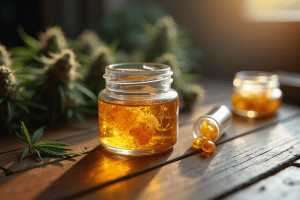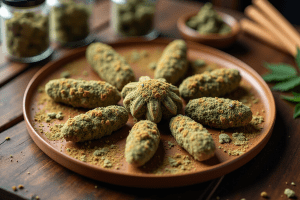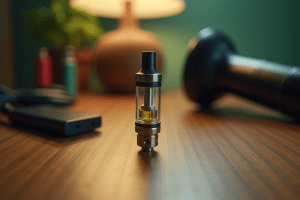Overview
The article thoughtfully explores the journey of detoxing from daily marijuana use, recognizing that the time required can differ greatly among individuals. Factors such as body fat percentage and metabolic rate play significant roles in this process. To support those on this path, a compassionate, step-by-step detox plan is outlined. This plan encourages you to:
- Stop cannabis use
- Stay hydrated
- Enjoy a nutrient-rich diet
- Engage in regular exercise
Each of these steps plays a vital role in helping to eliminate THC from your body over time.
Have you considered how these changes might impact your well-being? By taking these steps together, we can create a healthier future. It’s important to remember that every individual’s journey is unique, and it’s okay to seek support along the way. Let’s embrace this opportunity to make informed choices and move forward with confidence.
Introduction
In a world where cannabis use is becoming increasingly normalized, it’s vital to understand the intricacies of THC and its effects on our bodies. Tetrahydrocannabinol, the primary psychoactive compound in cannabis, interacts with our brains to produce a range of effects—from euphoria to altered perception. However, for many, the journey towards detoxification can feel daunting. As our bodies adjust to the absence of THC, challenges may arise.
This article explores the complexities of THC metabolism and highlights the importance of proper education. We will discuss the steps necessary to navigate the detox process effectively. By examining structured detox plans, healthy lifestyle changes, and strategies for managing cravings, we can empower ourselves to reclaim control over our cannabis use. Together, let’s embrace a healthier future.
Understand THC and Its Impact on Your Body
Tetrahydrocannabinol (THC), the primary psychoactive component of marijuana, interacts with cannabinoid receptors throughout our brain and body. This interaction can lead to feelings of euphoria, altered perceptions, and relaxation. However, it’s important to recognize that frequent use can result in dependence, as our bodies adapt to the presence of THC. Understanding how THC is metabolized is crucial for those wondering, ‘if I smoke everyday how long till I’m clean,’ especially when considering detoxification. This is particularly true for new marijuana users who may find themselves navigating a changing landscape of education around its effects.
Public education about marijuana has made significant strides, moving away from outdated scare tactics to a more fact-based approach. This modern perspective emphasizes the science behind how marijuana interacts with the developing brain, helping individuals—especially teens—understand the potential risks associated with early use. These risks can include impacts on academic performance and long-term aspirations. Since THC is lipophilic, it gets stored in fat cells, which means it can remain in our bodies for extended periods after use has stopped. The duration THC remains detectable varies widely based on several factors, including if I smoke everyday how long till I’m clean, individual body fat percentage, and metabolic rate. For instance, those who use marijuana daily might be concerned about the question, ‘if I smoke everyday how long till I’m clean,’ since THC can be detectable in their system for several weeks, while occasional users may eliminate it more quickly.
Recent studies reveal that the pharmacokinetics of THC are influenced by various factors, such as the method of consumption, genetic predispositions, and even concurrent alcohol use. These factors can complicate THC metabolism and potentially prolong its presence in the body. It’s also vital to be aware that some detox methods, like high doses of niacin, can lead to toxicity and hospitalization, making them risky options for those looking to cleanse their systems.
A case study on marijuana use disorder highlights that the frequency of use is a significant risk factor for developing dependence, particularly among adolescents. This underscores the importance of early intervention and education in mitigating the risks associated with marijuana use. Notably, the study indicates that teenagers who engage in regular marijuana use are at a heightened risk of developing substance use disorders. This reinforces the necessity for informed decision-making and accessible resources.
Experts emphasize that understanding how THC is stored in fat cells is essential for determining the answer to if I smoke everyday how long till I’m clean. As one health expert noted, “An interprofessional strategy for addressing substance use disorder can help guarantee the best possible outcomes for patients.”
In summary, THC metabolism is complex, and its effects can vary significantly among individuals. For those looking to cleanse, it is vital to consider the question, if I smoke everyday how long till I’m clean, to establish realistic goals and timelines. Moreover, recognizing the importance of knowledge and resource availability plays a crucial role in making informed decisions regarding marijuana use. Together, we can navigate this journey with understanding and support.
Follow a Step-by-Step Detox Plan
- Cease Cannabis Use: The first step we can take together is to stop all cannabis consumption. This allows THC to gradually exit your system. As Nelson Mandela wisely stated, “It always seems impossible until it’s done,” reminding us that overcoming challenges is indeed achievable.
- Prioritize Hydration: Staying well-hydrated is crucial for flushing out toxins. We should aim for 8-10 glasses of water daily, as proper hydration significantly enhances detoxification effectiveness. Did you know that studies indicate adequate hydration can alleviate common withdrawal symptoms, such as heightened anxiety and irritability? In fact, individuals who maintain proper hydration during cleansing may experience a 30% decrease in withdrawal symptoms.
- Adopt a Nutrient-Rich Diet: Let’s focus on a balanced diet filled with whole foods high in fiber, vitamins, and minerals. Including fruits, vegetables, whole grains, and lean proteins can assist your body during the cleansing process. Nutritionists emphasize that a well-rounded diet can aid in recovery and overall well-being.
- Engage in Regular Exercise: Physical activity is essential for boosting metabolism and facilitating the release of stored THC from fat cells. Aim for at least 30 minutes of moderate exercise most days. This not only supports your body but can also help mitigate withdrawal symptoms.
- Explore Natural Cleansing Aids: While some of us find herbal supplements or cleansing drinks beneficial, it’s important to consult with a healthcare provider before incorporating these into our regimen. Your health and safety are paramount.
- Track Withdrawal Symptoms: Let’s monitor any withdrawal symptoms, such as irritability or sleep disturbances, and seek support if necessary. Understanding your body’s reactions can empower you to handle the cleansing process efficiently.
The case study of Landmark Recovery illustrates the effectiveness of organized cleansing programs, emphasizing that accessible support can significantly enhance recovery outcomes. By adhering to this organized cleansing plan, we can manage the challenges of cannabis withdrawal with increased confidence and support each other on the path toward recovery. Remember, empowering ourselves to live life on our own terms is a crucial part of this journey.
Incorporate Healthy Lifestyle Changes
- Establish a Routine: Creating a structured daily schedule that includes designated times for meals, exercise, and relaxation is crucial. A regular routine not only helps control cravings but also eases anxiety, which is important to consider if I smoke everyday how long till I’m clean. Research shows that maintaining a routine can significantly enhance recovery outcomes, fostering a sense of stability and control. As Rikki Rogers wisely stated, “Strength doesn’t come from what you can do. It comes from overcoming the things you once thought you couldn’t.”
- Practice Mindfulness and Stress Management: Have you considered engaging in mindfulness techniques such as meditation, yoga, or deep breathing exercises? These practices can effectively alleviate stress and cravings. They enhance emotional regulation and decrease the chances of relapse, making them vital tools in your recovery journey. Asana Recovery’s Comprehensive Treatment Services highlight how structured support systems, particularly through mindfulness and stress management techniques, are effective in recovery.
- Get Adequate Sleep: Are you prioritizing 7-9 hours of quality sleep each night? This is vital for supporting your body’s recovery processes. Sleep plays a crucial role in mental health and overall well-being, assisting in the recovery of both the mind and body during purification.
- Avoid Triggers: It’s essential to identify and steer clear of situations or individuals that may provoke the urge to use cannabis again. This proactive approach helps maintain your focus on recovery and minimizes the risk of relapse, raising the question of if I smoke everyday how long till I’m clean.
- Seek Support: Have you thought about joining a support group or consulting with a therapist who specializes in substance use? This can provide invaluable guidance through the challenges of cleansing and recovery. Support systems are crucial for fostering resilience and accountability, enhancing the likelihood of successful recovery. With 64 blog posts published on related topics, there is a wealth of information available to support your detox journey.
Manage Cravings and Withdrawal Symptoms
- Recognize Triggers: Let’s start by recognizing the specific situations, emotions, or environments that provoke cravings. Understanding these triggers is essential for developing effective coping strategies. For instance, do you notice that stress or social situations increase your urge to use marijuana? Preparing for these scenarios can make a significant difference. It’s important to acknowledge that moderate evidence links high THC concentration marijuana use by adolescents and young adults to future mental health symptoms and disorders. This underscores the importance of managing cravings for our mental well-being.
- Use Distraction Techniques: Engaging in activities that occupy both your mind and body can be incredibly helpful. Hobbies, exercise, or spending time with supportive friends can serve as effective distractions. Research shows that physical activity not only diverts attention from cravings but also boosts mood and overall well-being. Many individuals who actively engage in distraction techniques report lower levels of cravings, highlighting the effectiveness of these methods.
- Stay Positive: It’s vital to maintain a focus on the advantages of giving up marijuana. Improved health, enhanced mental clarity, and financial savings are significant motivators. Have you considered keeping a journal to monitor these positive changes? This practice can strengthen your dedication to the cleansing process. It’s encouraging to note that the prevalence of marijuana use disorder decreased from 35.6% to 30.6% between 2001 and 2013, indicating that recovery is within reach.
- Consider Professional Help: If cravings become overwhelming, seeking assistance from a healthcare professional or counselor can provide valuable support. Professionals can offer tailored strategies and resources to help you navigate the challenges of withdrawal, ensuring you have the tools needed for success. Remember, as emphasized by the Centre for Addiction and Mental Health, while marijuana use can lead to cravings, it is important to understand that, unlike substances such as alcohol or opioids, an overdose is not fatal.
- Practice Self-Compassion: It’s essential to recognize that feeling cravings and withdrawal symptoms is a typical aspect of the cleansing process. Be kind to yourself and celebrate small victories along the way. Acknowledging your progress, no matter how small, can nurture resilience and promote ongoing dedication to your objectives.
In 2025, handling urges during substance withdrawal has gained more significance. Specialists highlight the necessity of identifying emotional triggers and utilizing diversion methods. Statistics show that common triggers for cravings include stress and social situations, emphasizing the need for effective coping strategies. By integrating these strategies, we can navigate the complexities of marijuana withdrawal more effectively. Additionally, understanding the risks associated with cannabis use, such as the statistic that 23% of individuals who used cannabis in the past year reported driving within 2 hours of consumption, reinforces the importance of effective coping strategies during detox.
Conclusion
Understanding THC and its effects on the body is essential for anyone considering detoxification. The complexities of THC metabolism highlight the importance of education, especially in recognizing the risks associated with frequent cannabis use. By ceasing consumption, prioritizing hydration, adopting a nutrient-rich diet, and engaging in regular exercise, we can effectively navigate the detox process together. Structured plans empower individuals to reclaim control over their cannabis habits, while a supportive environment enhances recovery outcomes.
Incorporating healthy lifestyle changes further aids in managing cravings and withdrawal symptoms. Have you considered how establishing a routine, practicing mindfulness, ensuring adequate sleep, and avoiding triggers can foster resilience during detox? Seeking support from professionals or support groups enriches the recovery experience and provides essential guidance.
Ultimately, the journey towards reclaiming control over cannabis use is achievable through informed decision-making and a commitment to personal well-being. By embracing education and structured detox strategies, we can pave the way for a healthier future, free from dependency on THC. Together, let’s take those steps towards a brighter tomorrow.
Frequently Asked Questions
What is tetrahydrocannabinol (THC) and how does it affect the body?
THC is the primary psychoactive component of marijuana that interacts with cannabinoid receptors in the brain and body, leading to feelings of euphoria, altered perceptions, and relaxation.
Can frequent use of THC lead to dependence?
Yes, frequent use of THC can result in dependence as the body adapts to its presence.
How does THC metabolism affect those who use marijuana regularly?
THC is lipophilic, meaning it gets stored in fat cells and can remain in the body for extended periods. The duration THC remains detectable varies based on factors like body fat percentage and metabolic rate, with daily users potentially having THC detectable for several weeks.
What factors influence the pharmacokinetics of THC?
The pharmacokinetics of THC can be influenced by the method of consumption, genetic predispositions, and concurrent alcohol use, which can complicate its metabolism and prolong its presence in the body.
Are there any risks associated with detox methods for THC?
Yes, some detox methods, such as high doses of niacin, can lead to toxicity and hospitalization, making them risky options for those trying to cleanse their systems.
What does research say about marijuana use disorder and adolescents?
Research indicates that the frequency of marijuana use is a significant risk factor for developing dependence, particularly among adolescents, highlighting the need for early intervention and education.
Why is understanding THC storage in fat cells important?
Understanding how THC is stored in fat cells is essential for determining how long it may remain in the body, which is crucial for those looking to cleanse.
What is the importance of knowledge and resources in making decisions about marijuana use?
Recognizing the importance of knowledge and resource availability is vital for making informed decisions regarding marijuana use, helping individuals navigate the complexities of THC metabolism and its effects.
Get Your Medical Card
Connect with a licensed physician online in minutes












